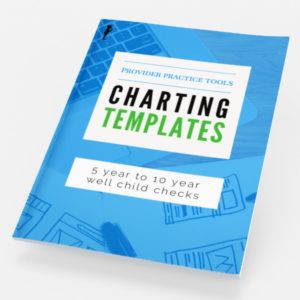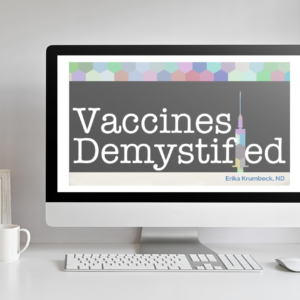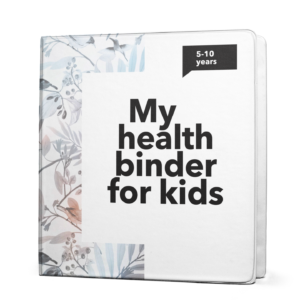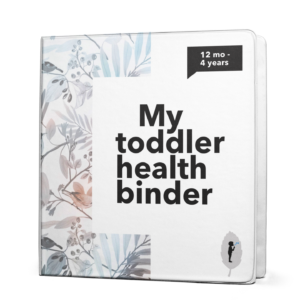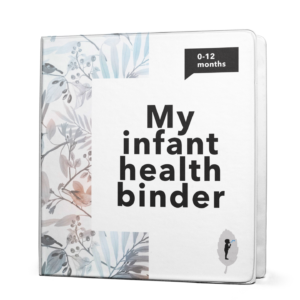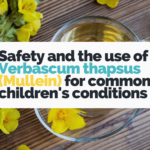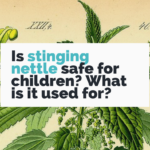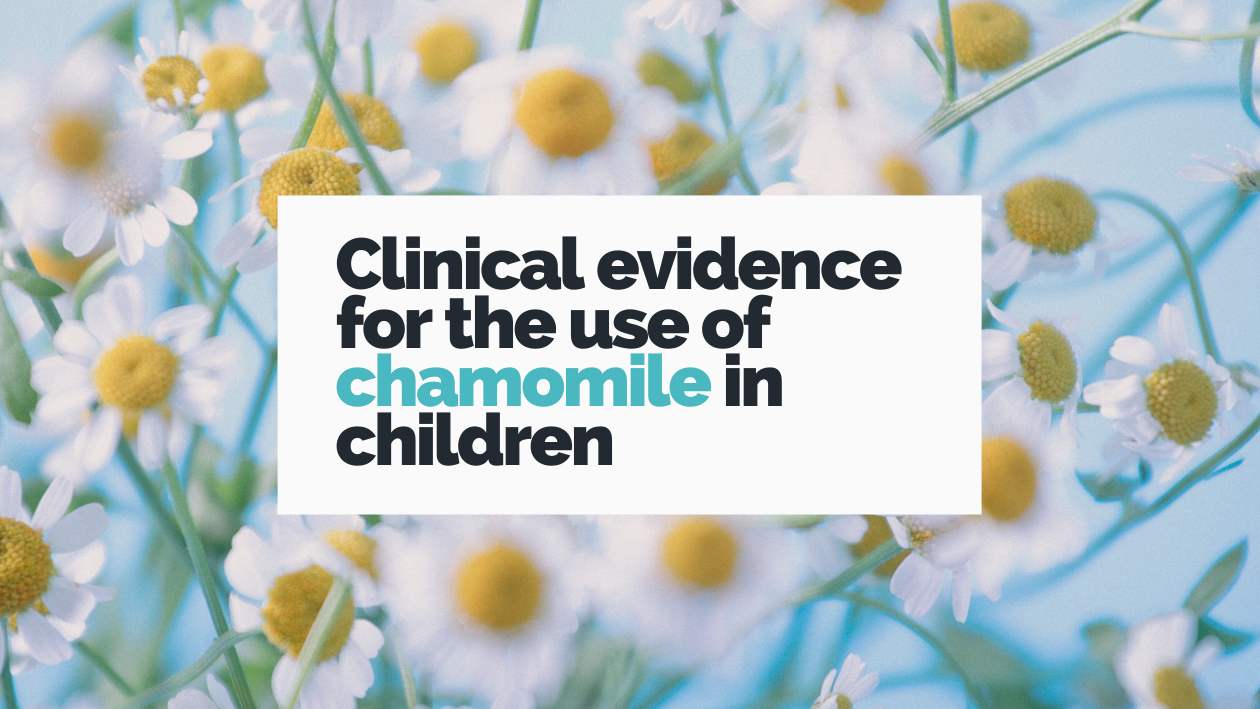
Clinical evidence for the use of chamomile (Matricaria chamomilla) in children
The Timeless Appeal of Chamomile
Chamomile, scientifically known as Matricaria chamomilla, is a widely used herb in traditional medicines around the world. Ancient Egyptian, Greek and Roman medical texts describe using chamomile as a calming tea infusion and for treating dry, weatherworn skin.1 Chinese medical traditions first detailed chamomiles’ (known as “Bamu Nai”) attributes during the 10th century in Uyghur medicine.2 Similarly, the Unani medicine system, prevalent in the Indian subcontinent, boasts a centuries-old association with chamomiles’ therapeutic potential.3 For thousands of years, chamomile served as a symbol bridging the spiritual with the wonder of medicine. Egyptians and Saxons regarded chamomile as sacred and in Slovakia it was customary for individuals to bow when encountering chamomile plants, a sign of deep respect.4 Native Americans incorporated chamomile into their practices employing it to create soothing aromas in sweat lodges to call on good spirits.5
Chamomile was first cultivated in the United States by German settlers and became an important medicine used by 19th century American Eclectic physicians, specifically for conditions in pregnant women and young children.6
Over the centuries, chamomile has been most renowned for its anti-inflammatory, analgesic, and calming qualities. Chamomile is primarily harvested during the flowering seasons, with its daisy-like flower heads collected and used to prepare various medicines including teas, tinctures, essential oils and poultices.7
Potentially Active Chemical Constituents
Chamomile’s medicinal potency is attributed to several key constituents, including sesquiterpenes, volatile oils, and flavonoid glycosides. Sesquiterpenes contribute to its anti-inflammatory and analgesic effects, while the volatile oils, such as alpha bisabolol, chamazulene, and matricin enhance its anti-inflammatory and antispasmodic qualities. Additionally, flavonoid glycosides, such as apigenin, provide potent antioxidant benefits.1,2,7,8 It is important to note that there are several subspecies of chamomile, but the most common varieties found in research and frequently used by herbalists are cultivated German and Roman chamomile.
German Chamomile
| Terpenoids | Alpha-bisbolol, alpha-bisabolol oxide A and B, chamazulene, sesquiterpenes |
| Flavonoids | Apigenin, luteolin, quercetin |
| Coumarins | Umbelliferone |
| Spiroethers | En-yn dicycloether |
| Other constituents | Anthemic acid, choline, tannin, polysaccharides |
Roman Chamomile
| Terpenoids | Chamazulene, bisabolol |
| Flavonoids | Apigenin, luteolin, quercetin |
| Coumarins | Scopoletin-7-glucoside |
| Other constituents | Angelic and tiglic acid esters, anthemic acid, choline, phenolic and fatty acids |
Due to the similarity of active chemical constituents, the term “chamomile” will continue to be used in this article to broadly describe multiple chamomile subspecies.
The Classic Children’s Herb
Chamomile is often celebrated as the classic children’s herb and boasts a unique combination of flavors and therapeutic benefits. While its slightly bitter taste may not be every child’s preference, this bitterness can be a valuable ally in stimulating digestion. This quality aids in the gentle relief of digestive discomfort. Beyond its hint of bitterness, chamomile offers a delightful fruity flavor that harmonizes seamlessly with other mint-family herbs like lemon balm and peppermint.
Chamomile’s volatile oils play a pivotal role in soothing intestinal gas, making it an ideal choice for comforting infants suffering from colic or children with stomach aches. In addition to its digestive prowess, chamomile possesses the remarkable ability to help lower mild-to-moderate fevers without artificially suppressing the body’s natural response to infections.
Furthermore, chamomile serves as a mild anxiolytic, making it a valuable resource for addressing insomnia and providing comfort to anxious or restless children, especially when they are feeling unwell. Beyond these uses, chamomile can be employed as a gargle to alleviate sore throats, tonsillitis, and assist in managing periodontal diseases and gingivitis. The versatility of chamomile as a remedy for common childhood ailments and discomforts underscores its enduring role in pediatric healthcare.
Is chamomile safe for children? Is chamomile safe in pregnancy or breastfeeding?
Chamomile is generally regarded as safe for most individuals; however, certain precautions should be considered. Individuals with hypersensitivity to plants in the asteraceae family are advised to avoid chamomile, as allergic reactions may occur.9
Pregnancy: Chamomile is considered category A, safe in pregancy by Mills & Bone, The Essential Guide to Herbal Safety. Pregnant women should always exercise caution when considering chamomile, especially in the early stages of pregnancy (before 12 weeks gestation). This herbs smooth muscle relaxing properties could potentially contribute to miscarriage, and as such, it is sometimes considered contraindicated in the first trimester.10 Nevertheless, chamomile has been used for thousands of years by herbalists and midwives for its ability to ease morning sickness and nausea. It is unlikely for a cup of chamomile tea in these instances to pose harm to pregnancy. Parents are advised to use chamomile in moderation and with caution during pregnancy and while breastfeeding.
Breastfeeding: Chamomile is considered compatible with lactation.
Children: Chamomile is considered safe for pediatric patients. Some children will enjoy the light, floral taste, however some children will find the mild bitter properties of chamomile unpleasant. Chamomile tea mixes with mint-family herbs well to hide the bitter taste. In pediatric care, precise dosing is imperative, as with any medication or herbal remedy, to ensure safety and effectiveness.
Chamomile in clinical and naturopathic medicine
Chamomile’s role in naturopathic medicine is significant owing to its wide-ranging therapeutic applications.
Digestive Health: Gastritis, Infantile Colic, Nausea & Diarrhea
Chamomile’s anti-inflammatory and spasmolytic properties are harnessed in treating digestive complaints. Chamomile has a long history of use for various gastrointestinal issues, including colic, diarrhea, stomachache, nausea, indigestion, ulcers and irritable bowel syndrome (IBS). It is known for its ability to alleviate gas, soothe upset stomachs and relax intestinal muscles.
- In a 2005 study involving 93 infants with colic, an extract of fennel, chamomile and lemon balm was tested against a placebo. The infants given the extract experienced significantly less daily crying time compared to those given the placebo, with no reported adverse effects.11
- More recently (2017), a randomized control trial of 176 infants with colic showed that a preparation containing chamomile, Melissa officinalis, and tyndallized Lactobacillus acidophilus HA122 as well as Lactobacillus Reuter DSM 17938, resulted in significantly lower daily crying time when compared to Simethicone, a common medication for gas and stomach relief.12
- In a 2007 publication in Pediatrics in Review, a double-blind study involving 68 colicky infants revealed that a chamomile tea mixture effectively alleviated colic symptoms in 57% of the infants, while the placebo exhibited beneficial effects in only 26% of cases.13
- During a clinical study conducted in 2006, which employed a randomized double-blind design and involved children between the ages of six months and five years experiencing non-complicated diarrhea, researchers investigated the impact of a formulation containing apple pectin and chamomile extract in comparison to a placebo. The pectin/chamomile group had a significantly shorter duration of diarrhea, ending at least five hours earlier than the placebo group. 14
- In a 2015 study of 45 adult individuals with IBS, daily consumption of Chamomile extract resulted in significant reductions in IBS symptoms during and after the intervention.15
- A commercial preparation called STW5 (Iberogast), containing extracts of multiple herbs including chamomile, has demonstrated statistically significant protection against gastric ulcers, lower gastric acidity and inhibit secondary hyperacidity.16 It is essential to consider the potential for adverse outcomes related to any preparation, as highlighted in a 2022 case report that described the diagnosis of Iberogast-Induced acute liver injury in a 32 year old woman.17
- In a research study published in the Journal of Gorgan University of Medical Sciences in 2012, which included 105 pregnant women, it was determined that chamomile capsules exhibited greater effectiveness in alleviating nausea and vomiting during early pregnancy when compared to ginger and placebo.18
- Furthermore, chamomile has also demonstrated beneficial effects on nausea and vomiting caused by chemotherapy for women with breast cancer and after laparoscopic cholecystectomy for both men and women.19,20
Eczema and other dermatologic considerations
Chamomile’s anti-inflammatory and antioxidant properties are an excellent choice for treating skin conditions such as eczema, dermatitis, diaper rash and nervous skin irritation. Chamomile has been used in bath and body products for centuries and fresh or dried flowers can be used in kitchen sink soaks for babies experiencing irritated skin issues.
- In a clinical study conducted by Aertgeerts et al. (1985), 161 adult patients with eczema were administered a chamomile extract-based cream. The chamomile cream exhibited a comparable effectiveness when compared to the steroidal cream and superior effectiveness to the non-steroidal cream. 21
- In vivo studies have demonstrated a variety of potential mechanisms and benefits of topical chamomile for skin health including reduction of allergic markers (serum IgG1, IgE and histamine), improved wound healing (including restoration of normal integument (skin) architecture, wound contraction, and transformation of growth factor-B1 and metalloproteinases-9/tissue inhibitor metalloproteinase-1 ratio), notable antibacterial activity when compared to topical tetracycline, and a reduction in symptomatic scratching behavior.22–24 Further investigation is needed to understand if these findings would be consistent in human research.
Mood and Sleep Disorders
Undoubtedly among the most extensively studied and relied upon by herbalists worldwide is the impact of chamomile on mood disorders such as anxiety, depression.
- A 2016 randomized control trial of 179 adult participants resulted at 8 found that chamomile produced a clinically meaningful reduction in GAD symptoms with a response rate comparable to those observed during conventional anxiolytic drug therapy and a favorable adverse event profile.25 At 12 weeks of intervention, these researchers reported significantly reduced moderate-to-severe generalized anxiety symptoms, but did not significantly reduce rates of relapse.26
- As part of a 2012 randomized control trial of 57 adults with co-morbid anxiety and depression, participants who received standardized chamomile extract were found to have significant improvement in depressive symptoms as reported via reduction in mean total Hamilton Depression Rating Scale.27
- In a similar randomized control trial featured in the 2020 edition of the Journal of Alternative and Complementary medicine, an examination was conducted to assess the outcomes from daily consumption of a standardized chamomile extract over an eight-week period in 179 adult patients with comorbid generalized anxiety disorder and depression. This study revealed clinically significant antidepressant and anxiolytic effects.28
- In a 2009 observational study involving three male psychiatric outpatients aged 14-16 years who were diagnosed with attention-deficit disorder (ADHD), notable improvements were noted in their Conners’ ADHD Rating Scale scores. This improvement was attributed to the proposed mechanism of action, which suggests that Matricaria chamomilla may function as a reuptake inhibitor for both noradrenaline and serotonin, which has been proven to be effective in previous ADHD cases.29
- Despite being the most commonly used herbal remedy for sleep disorders, research is mixed when it comes to efficacy for treating chronic primary insomnia. One study published in BMC Complementary and Medicine and Therapies in 2011 on 34 adult patients with DSM-V criteria for insomnia, reported only modest improvement in daytime functioning and no significant improvement in sleep diary measures, which included total sleep time, sleep efficacy, sleep latency, wake after sleep onset, sleep quality and number of awakenings.30 However, a 2017 randomized control trial evaluating the efficacy of chamomile extract on sleep quality among elderly people found significant improvement when compared to the control. 31
Rhinosinusitis & Allergic Rhinitis
Recently, more attention has been paid to herbal treatment for chronic and acute sinus infection including the use of chamomile.
- A 2021 randomized control study published in the American Journal of Otolaryngology revealed chamomile extract nasal drops to be effective in reducing clinical symptoms and improving quality of life in adult patients with chronic sinus infection.32
- Another study (2022) evaluating the effectiveness of an isotonic seawater spray with chamomile extract compared to other nasal washing solutions in 123 adult patients with allergic rhinitis found significant improvement in symptoms in patients receiving the chamomile intervention.33
Other Topics
Chamomile has been the focus of numerous research investigations aimed at assessing its potential efficacy in addressing various conditions, such as nocturnal and daytime enuresis,34 gingivitis,35 dysmenorrhea, 36 obesity, and related metabolic disorder, 37 among other health concerns.
Research Considerations
The above research suggests that chamomile may be a safe and effective option for individuals dealing with a variety of medical conditions. However, it is important to acknowledge the limitations of the scientific studies previously discussed. The small sample sizes make it challenging to draw broad conclusions. Furthermore, it is essential to recognize that children aren’t simply miniature versions of adults; their physiological systems and tolerance levels differ significantly. Consequently, applying findings from adult research to pediatric populations should be approached cautiously. The same is true when considering in vivo research. Considering the enduring presence of this herb in the herbal medicine tradition, coupled with millennia of anecdotal evidence and its favorable safety record, there is likely minimal risk to trialing this plant as an adjunctive or low intervention therapy.
In Closing: The Versatile Wonders of a Timeless Herb
Chamomile is a powerhouse of natural healing. With its rich history in traditional medicine and modern scientific validation, chamomile continues to provide solace and relief to those who seek its gentle embrace. While we acknowledge study limitations, the centuries of anecdotal evidence and its safety record invite us to explore chamomile as a gentle, complementary therapy. Whether you’re using it to unwind after a long day, soothe a colicky baby, or address a range of health concerns, chamomile is a testament to the enduring power of herbal medicine. Its legacy lives on, reminding us of nature’s infinite wisdom and its role in nurturing both our bodies and souls.
References:
1. Srivastava JK, Shankar E, Gupta S. Chamomile: A herbal medicine of the past with bright future. Mol Med Rep. 2010;3(6):895-901. doi:10.3892/mmr.2010.377
2. Dai YL, Li Y, Wang Q, et al. Chamomile: A Review of Its Traditional Uses, Chemical Constituents, Pharmacological Activities and Quality Control Studies. Molecules. 2022;28(1):133. doi:10.3390/molecules28010133
3. The Unani Pharmacopoeia of India. Vol 2. Government of India, Ministry of Health and Family Welfare, Department of Ayurveda, Yoga & Naturopathy, Unani, Siddha and Hoemopathy; 2007.
4. Engels G, Brinckmann J. Chamomile: MAatricaria Chamomilla (syn. M. recutita, Chamomilla recutita). Herb Gram. (108):8-17.
5. Osceola Naranjo L. The Native American Herbalist’s Bible.; 2021.
6. Blumenthal M, Brinckmann J. Chamomile Monograph. American Botanical Counsil. Published 2000. Accessed October 25, 2023. https://www.herbalgram.org/resources/abc-clinical-guide/table-of-contents/herb-chapters-clinical-overviews-patient-sheets-and-single-herb-monographs/chamomile/
7. Tlinger S. Herbal Medicine from the Heart of the Earth. 2nd ed. Wise Acres; 2009.
8. Gardiner P. Chamomile (Matricaria recutita, Anthemis nobilis). Published online 1999.
9. Juarascio A, Cuellar NG, Gooneratne NS. Chapter 9 – Alternative Therapeutics for Sleep Disorders. In: Barkoukis TJ, Matheson JK, Ferber R, Doghramji K, eds. Therapy in Sleep Medicine. W.B. Saunders; 2012:126-139. doi:10.1016/B978-1-4377-1703-7.10009-X
10. Stansbury J. Herbal Formularies for Health Professionals: Digestion and Elimination. Vol 1. Chelsea Green Publishing; 2018.
11. Savino F, Cresi F, Castagno E, Silvestro L, Oggero R. A randomized double-blind placebo-controlled trial of a standardized extract of Matricariae recutita, Foeniculum vulgare and Melissa officinalis (ColiMil) in the treatment of breastfed colicky infants. Phytother Res PTR. 2005;19(4):335-340. doi:10.1002/ptr.1668
12. Martinelli M, Ummarino D, Giugliano FP, et al. Efficacy of a standardized extract of Matricariae chamomilla L., Melissa officinalis L. and tyndallized Lactobacillus acidophilus (HA122) in infantile colic: An open randomized controlled trial. Neurogastroenterol Motil. 2017;29(12). doi:10.1111/nmo.13145
13. Weizman Z, Alkrinawi S, Goldfarb D, Bitran C. Efficacy of herbal tea preparation in infantile colic. J Pediatr. 1993;122(4):650-652. doi:10.1016/s0022-3476(05)83557-7
14. de la Motte S, Böse-O’Reilly S, Heinisch M, Harrison F. [Double-blind comparison of an apple pectin-chamomile extract preparation with placebo in children with diarrhea]. Arzneimittelforschung. 1997;47(11):1247-1249.
15. Agah S, Taleb A, Moeini R, Gorji N, Nikbakht H, Soltani-Kermanshahi M. Chamomile efficacy in patients of the irritable bowel syndrome. Published online 2015.
16. Khayyal MT, Seif-El-Nasr M, El-Ghazaly MA, Okpanyi SN, Kelber O, Weiser D. Mechanisms involved in the gastro-protective effect of STW 5 (Iberogast) and its components against ulcers and rebound acidity. Phytomedicine Int J Phytother Phytopharm. 2006;13 Suppl 5:56-66. doi:10.1016/j.phymed.2006.03.019
17. Leroy A, Perrin H, Porret R, et al. Iberogast®-Induced Acute Liver Injury—A Case Report. Gastro Hep Adv. 2022;1(4):601-603. doi:10.1016/j.gastha.2022.02.020
18. Modares M, Besharat S, Rahimi K, Mahmoudi M, Salehi Sourmaghi H. Effect of Ginger and Chamomile Capsules on nausea and vomiting in pregnancy. Modares M, Besharat S, Rahimi Kian, Besharat S, Mahmoudi M, Salehi Sourmaghi H. J Morgan Univ Med Sci 2012, 14(1): 46-51. J Gorgan Univ Med Sci. 2012;14(1):46-51.
19. Bakhti̇ari̇ S, Khali̇li̇ G, Zadak RS. The effect of chamomile on nausea and vomiting after laparoscopic cholecystectomy: A triple-blind randomized clinical trial. J Exp Clin Med. 2023;40(1):31-36.
20. Sanaati F, Najafi S, Kashaninia Z, Sadeghi M. Effect of Ginger and Chamomile on Nausea and Vomiting Caused by Chemotherapy in Iranian Women with Breast Cancer. Asian Pac J Cancer Prev APJCP. 2016;17(8):4125-4129.
21. Patzelt-Wenczler R, Ponce-Pöschl E. Proof of efficacy of Kamillosan(R) cream in atopic eczema. Eur J Med Res. 2000;5(4):171-175.
22. Gad HA, Abd El-Rahman FAA, Hamdy GM. Chamomile oil loaded solid lipid nanoparticles: A naturally formulated remedy to enhance the wound healing. J Drug Deliv Sci Technol. 2019;50:329-338. doi:10.1016/j.jddst.2019.01.008
23. Kazemian H, Ghafourian S, Sadeghifard N, et al. In vivo Antibacterial and Wound Healing Activities of Roman Chamomile (Chamaemelum nobile). Infect Disord Drug Targets. 2018;18(1):41-45. doi:10.2174/1871526516666161230123133
24. Lee SH, Heo Y, Kim YC. Effect of German chamomile oil application on alleviating atopic dermatitis-like immune alterations in mice. J Vet Sci. 2010;11(1):35-41. doi:10.4142/jvs.2010.11.1.35
25. Keefe JR, Mao JJ, Soeller I, Li QS, Amsterdam JD. Short-term open-label chamomile (Matricaria chamomilla L.) therapy of moderate to severe generalized anxiety disorder. Phytomedicine Int J Phytother Phytopharm. 2016;23(14):1699-1705. doi:10.1016/j.phymed.2016.10.013
26. Mao JJ, Xie SX, Keefe JR, Soeller I, Li QS, Amsterdam JD. Long-term chamomile (Matricaria chamomilla L.) treatment for generalized anxiety disorder: A randomized clinical trial. Phytomedicine Int J Phytother Phytopharm. 2016;23(14):1735-1742. doi:10.1016/j.phymed.2016.10.012
27. Amsterdam JD, Shults J, Soeller I, Mao JJ, Rockwell K, Newberg AB. Chamomile (Matricaria recutita) May Have Antidepressant Activity in Anxious Depressed Humans – An Exploratory Study. Altern Ther Health Med. 2012;18(5):44-49.
28. Amsterdam JD, Li QS, Xie SX, Mao JJ. Putative Antidepressant Effect of Chamomile (Matricaria chamomilla L.) Oral Extract in Subjects with Comorbid Generalized Anxiety Disorder and Depression. J Altern Complement Med. 2020;26(9):815-821. doi:10.1089/acm.2019.0252
29. Niederhofer H. Observational study: Matricaria chamomilla may improve some symptoms of attention-deficit hyperactivity disorder. Phytomedicine. 2009;16(4):284-286. doi:10.1016/j.phymed.2008.10.006
30. Zick SM, Wright BD, Sen A, Arnedt JT. Preliminary examination of the efficacy and safety of a standardized chamomile extract for chronic primary insomnia: A randomized placebo-controlled pilot study. BMC Complement Altern Med. 2011;11(1):78. doi:10.1186/1472-6882-11-78
31. Adib-Hajbaghery M, Mousavi SN. The effects of chamomile extract on sleep quality among elderly people: A clinical trial. Complement Ther Med. 2017;35:109-114. doi:10.1016/j.ctim.2017.09.010
32. Nemati S, Yousefbeyk F, Ebrahimi SM, FaghihHabibi AF, Shakiba M, Ramezani H. Effects of chamomile extract nasal drop on chronic rhinosinusitis treatment: A randomized double blind study. Am J Otolaryngol. 2021;42(1):102743. doi:10.1016/j.amjoto.2020.102743
33. Atar Y, Karaketir S, Aydogdu I, et al. Comparison of Isotonic Seawater Nasal Spray Containing Chamomile Liquid Extract and Other Isotonic Seawater Nasal Washing Solutions for Allergic Rhinitis. Ann Otol Rhinol Laryngol. 2022;131(4):427-434. doi:10.1177/00034894211025411
34. Sharifi H, Minaie MB, Qasemzadeh MJ, Ataei N, Gharehbeglou M, Heydari M. Topical use of Matricaria recutita L (Chamomile) Oil in the Treatment of Monosymptomatic Enuresis in Children: A Double-Blind Randomized Controlled Trial. J Evid-Based Complement Altern Med. 2017;22(1):12-17. doi:10.1177/2156587215608989
35. Schönknecht K, Surdacka A, Rudenko L. EFFECTIVENESS OF COMPOSED HERBAL EXTRACT IN THE TREATMENT OF GINGIVITIS AND ORAL AND PHARYNGEAL MUCOSA – REVIEW OF STUDIES. Wiadomosci Lek Wars Pol 1960. 2021;74(7):1737-1749.
36. Niazi A, Moradi M. The Effect of Chamomile on Pain and Menstrual Bleeding in Primary Dysmenorrhea: A Systematic Review. Int J Community Based Nurs Midwifery. 2021;9(3):174-186. doi:10.30476/ijcbnm.2021.87219.1417
37. Bayliak MM, Dmytriv TR, Melnychuk AV, Strilets NV, Storey KB, Lushchak VI. Chamomile as a potential remedy for obesity and metabolic syndrome. EXCLI J. 2021;20:1261-1286. doi:10.17179/excli2021-4013


